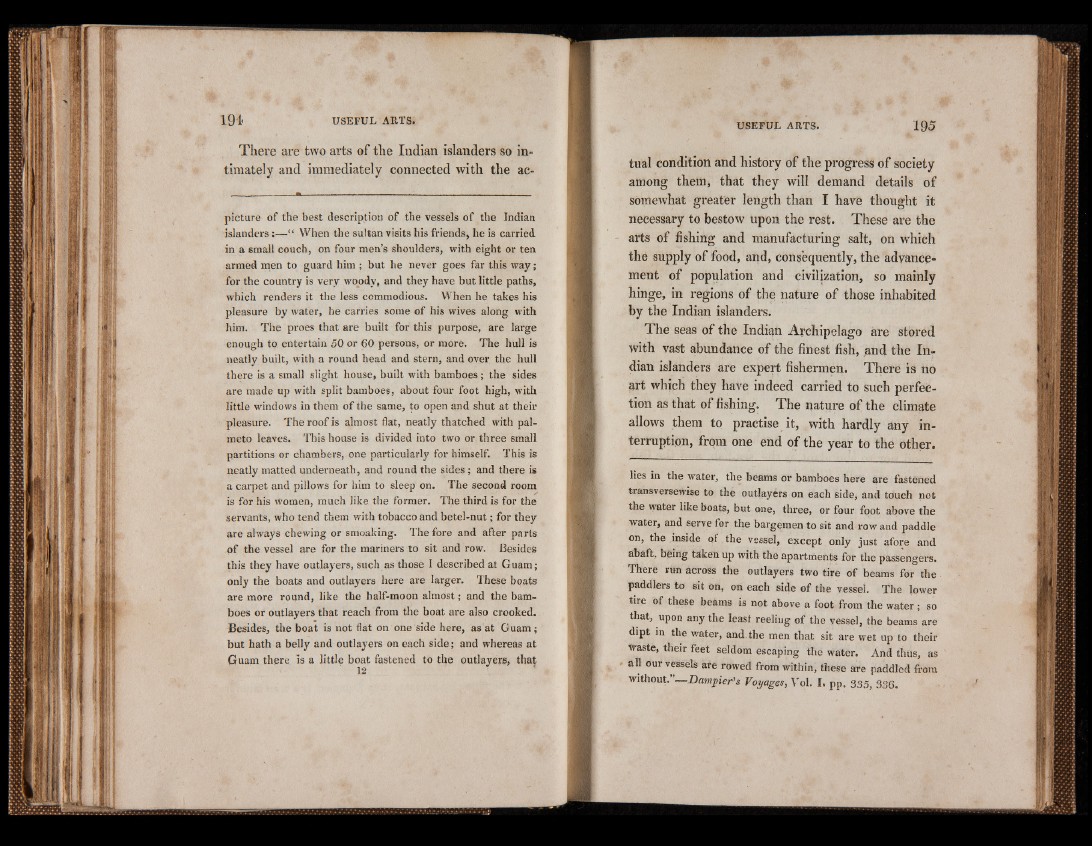
There are two arts of the Indian islanders so intimately
and immediately connected with the acpicture
of the best description of the vessels of the Indian
islanders :—“ When the sultan visits his friends, he is carried
in a small couch, on four men’s shoulders, with eight or ten
armed men to guard him ; but he never goes far this way;
for the country is very wqodv, and they have but little paths,
which renders it the less commodious. When he takes his
pleasure by water, he carries some of his wives along with
him. The proes that are built for this purpose, are large
enough to entertain 50 or 60 persons, or more. The hull is
neatly built, with a round head and stern, and over the hull
there is a small slight house, built with bamboes; the sides
are made up with split bamboes, about four foot high, with
little windows in them of the same, to open and shut at their
pleasure. The roof is almost flat, neatly thatched with pal-
meto leaves. This house is divided into two or three small
partitions or chambers, one particularly for himself. This is
neatly matted underneath, and round the sides ; and there is
a carpet and pillows for him to sleep on. The second room
is for his women, much like the former. The third is for the
servants, who tend them with tobacco and betel-nut; for they
are always chewing or smoaking. The fore and after parts
of the vessel are for the mariners to sit and row. Besides
this they have outlayers, such as those I described at Guam;
only the boats and outlayers here are larger. These boats
are more round, like the half-moon almost; and the bamboes
or outlayers that reach from the boat are also crooked.
Besides, the boat is not flat on one side here, as at Guam ;
but hath a belly and outlayers on each side; and whereas at
Guam there Is a little boat fastened to the outlayers, tha$
tual condition and history of the progress of society
among them, that they will demand details of
somewhat greater length than I have thought it
necessary to bestow upon the rest. These are the
arts of fishing and manufacturing salt, on which
the supply of food, and, consequently, the advancement
of population and civilization, so mainly
hinge, in regions of the nature of those inhabited
by the Indian islanders.
The seas of the Indian Archipelago are stbred
with vast abundance of the finest fish, jand the Indian
islanders are expert fishermen. There is no
art which they have indeed carried to such perfection
as that of fishing. The nature of the climate
allows them to practise it, with hardly any interruption,
from one end of the year to the other.
lies in the water, the beams or bamboes here are fastened
transversewise to the outlayers on each side, and touch not
the water like boats, but one, three, or four foot above the
water, and serve for the bargemen to sit and row and paddle
on, the inside of the vessel, except only just afore and
abaft, being taken up with the apartments for the passengers.
There run across the outlayers two tire of beams for the
paddlers to sit on, on each side of the vessel. The lower
tire of these beams is not above a foot from the water; so
that, upon any the least reeling of the vessel, the beams are
dipt in the water, and the men that sit are wet up to their
tvaste, their feet seldom escaping the water. And thus, as
all our vessels are rowed from within, these are paddled from
without. ’—Dumpier's Voyages, Vol. I. pp. 335, 3 3 Q,